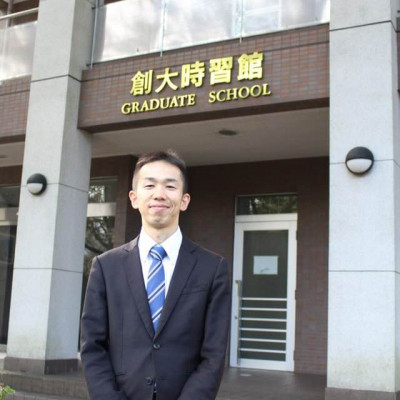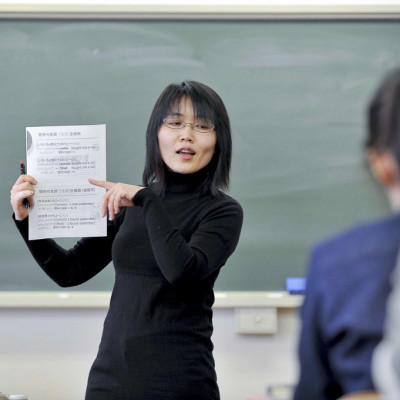Sessions / Paper presentation
Learning 21st-century skills and cross-cultural awareness through collaborative learning during the COVID-19 #3085
The purpose of this study is to investigate the effects of dialogue with CCC (Campus Crusade for Christ) members (1 CCC vs 3 students) on the attitudes of Japanese English learners toward communicating in English. Through the use of surveys and pre-post OPIc Speaking Tests, the authors investigate how students feel about speaking English and the effects of regular encounters with CCC members on their confidence and ability to communicate. From April 2021 to January 2022, the participants were 17 Japanese university students who studied English and presentation skills through a variety of topics derived from epistemology and ontology in order to prepare for a digitalized society 5.0. The pedagogical training was geared toward assisting students in identifying and solving the many critical issues facing humanity in the twenty-first century. A strong emphasis was placed on the development of higher-order thinking skills as well as the integration of ICT and human discourse throughout the 30-week online course. The students delivered numerous presentations using digital storytelling techniques on topics such as the Sustainable Development Goals (SDGs), global leadership, artificial intelligence (AI), cross-cultural quotient about different cultures, EduTech (21st-century skills), science and theology, and more. Aside from that, young foreigners visited virtual courses roughly every two or three weeks to assist students with presentations and debates. They also evaluated the students' presentations using the PeerEval program, which was provided by the university. The results showed that the mean OPIc speaking test score increased from 6.7 (standard deviation:1.36) to 7.4 (standard deviation:1.36) (SD:1.97). The classes they observed throughout the two semesters changed their ideas on studying cross-cultural communication skills and English proficiency, contextualizing and socializing their learning in the setting of an engaged and meaningful training environment. The results of the questionnaires that were conducted will be discussed in greater depth.
Self Access Learning and Minecraft: Student Perceptions #3094
Minecraft is an interactive virtual sandbox that came out in 2011. Despite its age, its popularity has continued to rise. The authors have created a Minecraft server for their students at a private Japanese university. This university puts great effort into its English Self Access Center (SALC), offering a variety of options for students to practice their English and focus on their skills or learning goals. In an effort to expand the offerings of this SALC, the two authors introduced a Minecraft server with an “English Please” mentality, not forcing any language usage but encouraging English usage when students felt comfortable to do so. During this phase of the project, the authors focused on the student perceptions of Minecraft after introducing a persistent survival mode option as well as a creative mode option to coincide with other themed events such as Halloween and Christmas. Initially, 130 students surveyed indicated an interest in participating in a Minecraft server set up and run by the SALC. Of those students, 28 joined a discussion forum (Microsoft Teams), and roughly 20 have logged into the server at least one time during the three months of the first phase. At the completion of phase one, the authors surveyed the students electronically for their impressions of the server. Questions centered around the reasons for joining or not joining the server after stating interest in the initial survey, ways to improve the experience, and gaining an understanding of student expectations for the Minecraft server community. These insights from the surveys in addition to the interactions and observations of the authors have led to changes in how they will implement Phase 2.
Teachers' Attitudes and Perceptions on Implementing Mobile AR for the Teaching of Italian as a Foreign Language #3025
Augmented Reality (AR) is an emergent technology that is revamping the educational environment (Lee, 2020). Despite the plethora of advantages that AR has demonstrated in a number of disciplines, its implementation for second and foreign language teaching is still limited and it requires further investigation (Pegrum, 2021). Although AR offers the opportunity for the creation of linguistically and culturally authentic domains, the majority of educators are unfamiliar with this emergent technology. Therefore, the role of teachers as designers and facilitators it is still a critical factor (Parmaxi, Demetriou, 2020). On the other hand, the most explored target languages are English and Chinese and although less commonly taught languages are being investigated, the study of AR for the Teaching of Italian as a Foreign Language (TIFL) is limited to one empirical research (Cervi-Wilson, Brick, 2018). Against these backdrops, the researcher implemented an Action Research study, focussing on the perceptions of IFL teachers in Argentina. The investigation aimed to highlight the perspective of educators when engaged in the process of designing and implementing AR activities for adolescent students through a mobile AR tool, in a context where economic and technological resources can be limited. Data collected are presented and initial findings of the pilot study are discussed. In line with other researches (Chen et al., 2020; Taskiran, 2019), the analysis showed that according to the perceptions of teachers, AR has the potential to enhance student motivation, since it enables the delivery of language and cultural contents with an engaging and meaningful approach for adolescent students. However, although teachers’ positive attitudes towards AR implementation, the research highlighted the need of long-term, ongoing technical training for teachers, since it is crucial to support an effective integration of the technology in classroom. Moreover, the initial findings highlight the need for an open-source, code free, mobile AR platform specifically designed for language teachers. Becoming equipped with skills and tools to integrate AR in language teaching and learning, educators can indeed customise this emergent technology and avoid the situation where AR learning design is mainly managed by information technology specialists, that ignore students’ needs and have a limited understanding of effective pedagogies.
Effects of metacognitive instruction and online game-based learning on promoting EFL listening ability #3035
This study attempts to investigate the effect of the blended learning mode involved in metacognitive instruction and online game-based learning on promoting EFL students' listening ability. Fifty EFL students in a five-year junior college in Taiwan are included in this teaching practices within an eight-week training. The first four weeks, students underwent a series of metacognitive strategies enhanced instruction, entailing self-regulated listening practices, listening buddies, and metacognitive strategies instruction in class. The second four weeks, students were provided with the online game-based learning platform, designed by the instructor and a group of educational-technology-major university students. The online game serves as a self-pace learning tool, containing four parts: vocabulary builder, two different vocabulary games and a listening comprehension test. Students could review the vocabulary with their own pace and fulfill the games and listening test subsequently. By implementing online games, we expect to investigate the perpetuated effect on games with metacognitive instruction on ESL ‘s listening comprehension. The result showed the significant gains from pre- to post- to delayed post tests on students' listening comprehension, indicating the series of metacognitive listening instruction had positive effect on students’ listening ability, with online games amplified the effect. Metacognitive Awareness Listening Questionnaire (MALQ), composing of five areas of metacognitive awareness: problem solving, planning and evaluation, mental translation, directed attention, and person knowledge, showed the similar effect from pre to post MALQ among these five areas. However, students delay MALQ had significant different effect in terms of “directed attention” area, pinpointing the importance of online games. Qualitatively, students’ listening reflected diary signaled the significance of the awareness of listening context and key words as well as the exposure to online game-based practices.
Developing and piloting an application for measuring real-time learner engagement levels in foreign language classrooms. #3066
This presentation reports on the piloting of a smartphone application designed to measure learner engagement in the language classroom. Students report their engagement via this app throughout each lesson, while teachers view live analytics of the students’ social, affective, and cognitive engagement in real-time. We attempted to measure the engagement levels of 124 learners over 15 weeks of online synchronous lessons, while also gathering their perceptions and the experiences of the participating teachers. This presentation demonstrates how engagement measures such as this can be used to innovate classroom teaching and learning, while also highlighting limitations in the application. This work was supported by a JSPS KAKENHI Grant as part of a Japanese MEXT Grants-in-Aid for Scientific Research.
From asynchronous online to flipped learning: Design principles and implementation #3082
The COVID-19 pandemic has forced instructors to adapt courses to fully online delivery, including asynchronous formats. In their own asynchronous courses, the researchers aimed to move beyond emergency remote teaching in two ways. First, they endeavored to create video materials that could be reused in future incarnations of the courses as flipped learning. Second, they developed four design principles for video-based asynchronous content courses based on previous research (e.g., Guo, Kim, & Rubin, 2014) and learning theory (e.g., Brame, 2016; Krashen, 1987) to encourage student engagement and learning. These principles include recommendations for video length, instructor presence, content, and technical quality.
The presenters will first explain the principles for designing video-based asynchronous content courses and how they implemented them in two English-medium content courses for undergraduate students at a Japanese university. Next, they will discuss the conversion of the asynchronous courses to flipped learning. The conversion requires developing new content to be used in the face-to-face (or synchronous online) classroom. Finally, the presenters will share the preliminary results of an ongoing investigation into the effectiveness of the flipped course materials based on pre-semester and weekly student questionnaires. The presentation will conclude with a discussion of how the courses and the study can be improved in the future.
Gamifying Task-Based Learning to Further Support L2 Acquisition and Motivation #2927
This presentation explores the application of gamification to task-based learning. Specifically, the presentation looks at how tasks can be re-imagined as game-like quests. The use of quests in an educational setting is referred to as quest-based learning (QBL) (Haskell, 2012). QBL can be a stand-alone pedagogical approach, or it can be part of a gamified class, interconnected with other gamification components such as leaderboards, points, levels, badges, and a narrative (Sheldon, 2011). The presentation details how quests should be designed to achieve specific EFL-related goals related to language acquisition. Research findings are presented to support the discussion.
Ready, set…? End-user testing of an AR treasure hunt learning game #3070
This presentation describes testing of “KSU Treasure Hunter”, a campus guide smartphone app designed and developed by the researchers. The app presents practical information about campus services in a bilingual, pirate treasure hunt-themed Augmented Reality learning game. Testing was designed to fill a gap in research that balances concerns with both learning, including game design, in-game experience and behaviors, and pedagogy, specifically in-game pedagogical features. It involved the collection of anecdotal evidence from surveys and interviews, and descriptive evidence from observations of the behavior of testers from three distinct groups: students, instructors, and stakeholders. The survey asked testers to rate learning, engagement, and usability. Survey data showed that testers (N=21) rated learning significantly higher than both engagement (p<0.01) and usability (p<0.01), and that engagement was also rated significantly higher than usability (p<0.05). There was only significant difference between the student, instructor, and stakeholder groups in ratings of engagement. Stakeholders (n=6) rated engagement significantly higher than either students (n=10, p<0.05) or instructors (n=5, p<0.05). Interviews with testers raised issues concerning usability and engagement. Observations of testers noted indicators of engagement, frustration, and unanticipated patterns of usage. Some of the major improvements to the app as a result of testing concerned learning by modifying app design, and in-app experience and behaviors. Other changes were made with the classroom implementation of the app in a pedagogical sequence in mind. The presentation concludes with plans to investigate the pedagogical soundness of the learning game.
Influence of Using Online Tools for Self-Regulated Strategy Development on Emergent Researchers' Academic Writing #3087
Learners with self-regulation skills have better academic writing achievement levels. With the advances in technology, online tools are designed to support EFL writers’ academic writing. Systematic trainings on self-regulated strategy development and the applications of online tools into academic writing have been suggested. Online tools were introduced and integrated into two academic writing courses in a university in northwest Taiwan. Twenty-six seniors and twelve first-year graduate students were recruited based on the convenience sampling method. Moving beyond the current empirical studies on self-regulated strategy development on academic writing on one specific writing process, this case study explored the influence of using online tools for fostering these participants’ self-regulated strategy development and academic writing from outlining, drafting, and revising. The descriptive analysis of the questionnaire and thematic analysis of the qualitative data (e.g. the instructor’s PowerPoint slides, participants’ learning records on self-regulated tools, and participants’ writing tasks) reached the following conclusions. First, participants tended to use online tools to self-monitor and self-correct their writing, rather than peer-review. Secondly, with the instructor’s instruction on the structure of academic writing via PowerPoint slides, participants were more motivated to use online tools (e.g. Linggle, Grammarly, Endnote, Google checklist) to structure their academic writing. Thirdly, participants’ educational background and past learning experience affected their motive and attitude toward self-regulated strategy development in academic writing. To effectively improve emergent researchers’ academic writing, two major suggestions were proposed.
Teachers' Pedagogical Scaffolds in Ludic Language Pedagogy: Implementing Synthesis of Qualitative Data (SQD) Model #3053
Ludic language pedagogy is concerned with exploring games and plays in language teaching contexts (York et al., 2021). This approach uses a playful disposition toward curricular design and encourages academic work through games or playful activities. But current research on games in language education lacks details regarding the role of teachers and scaffolds teachers use to integrate games and play into teaching. Thus, we explored teachers’ supports in game-based language teaching from students’ perspectives. In this study, teachers’ pedagogical scaffolds was measured based on the six support strategies of Synthesis of Qualitative Data (SQD-model) composed of different support strategies of role model, instructional design, authentic experience, collaboration, reflection, and feedback. Through a qualitative lens, seven first-year university students in the Iranian EFL context engaged in game-based language learning and were interviewed regarding their teachers’ pedagogical scaffolds during the training sessions. Qualitative content analysis was used for data analysis. The findings showed that role models provided sufficient understanding of games and mirrored the educational use of games among the strategies. The second most favorable strategy was the collaboration through which the participants had adequate opportunities to work together and share ideas, which reduced their anxiety. The findings also suggested that although all of the strategies were sufficiently addressed during game-based learning, the participants felt that the teacher did not give them sufficient support for reflective practice. The significance of the study is crucial to understand that the role of teachers is imperative for the game-based learning experience. Also, it shed light on what teachers’ roles can add to language and literacy learning. Moreover, findings will contribute to a community of practices around games that can be nurtured, cultivated, and eventually propagated across multiple classroom contexts and settings.
Using Free Online Technology to Improve English Ability: Extensive Reading through MReader to Encourage Autonomous Learning #3068
Teaching reading to students as a second or foreign language can be a challenge for teachers as many students tend to find reading itself a dull and boring activity; however, reading also has many benefits that aid students in developing their overall English ability. This paper investigates how extensive reading (ER) with the free online application of MReader benefits students in reading and other English language skills. Through a quantitative survey and two reading-speed tests conducted over a period of one academic year, the findings show that the students improved in their reading speed, and felt improvement in their overall English ability including vocabulary, speaking, and confidence. The findings show that through ER and MReader, students can gain motivation and become autonomous learners outside the classroom. This paper also introduces ways for teachers and schools to implement reading programs into already established academic programs without interruption or burden through online technology.
An Innovative Approach of Using a VR Platform for Students to Teach English as Teachers #3071
Benefits of Virtual Reality (VR) for education, such as increasing engagement (Hu-Au & Lee, 2017) and increasing intercultural awareness, and reducing affective filter (Schwienhorst, 2020), are reported. In Saito’s (2021) study, university students who experienced VR English lessons using a VR platform, Immerse, reported that they were able to lower their anxiety and increase their confidence in speaking English. A new project where four third-year students with high-intermediate English proficiency who had experienced the VR English lessons in 2019 planned English lessons using the same platform and offered VR English lessons to eight second-year students with low-intermediate English proficiency. The five-month project was based on constructivism and socio constructivism, and its objective was for the third-year students to learn about English lessons through experience of teaching using the VR platform and to offer them an opportunity to work collaboratively toward the project. At the end of the project, they wrote a collaborative report with their feedback about the project. An interview with the four students working as the teachers were conducted. In this presentation, I will report the outline of the project and the results of analyzing the report and the interview in terms of what they learned from teaching English using the VR platform and whether they were able to work collaboratively through the project. Also, they indicated that the project where they worked as teachers helped them improve their speaking. From this innovative approach of using the VR platform, a new direction of future research such as whether students teaching English in VR can help them improve English and lower their foreign language anxiety and whether VR English lessons can be integrated into teacher training will be discussed.
Assessing the Effectiveness of Watching Gameplay for Language Learning Purposes #3040
Digital Game-based Language Learning (DGBLL) is a branch of Computer-assisted Language Learning (CALL) that involves playing digital games to learn a language, utilizing various game elements inducive to motivation and learning. The field has two areas of focus: Off-the-shelf (OTS) games, also known as non-serious games, are created solely for entertainment, while serious games are developed with education in mind. Many studies have indicated the positive effects of DGBLL applications. Nevertheless, DeHaan, Reed, and Kuwada (2010) found that interactivity, the control of gameplay through controllers, negatively influenced vocabulary learning because of its added mental requirements. Conversely, participants who watched gameplay had better vocabulary retention. Several studies have further addressed the influence of game interactivity and learning but predominantly consist of serious games developed by educators; only a few related studies involve OTS games. Thus, the potential of watching OTS gameplay for language learning purposes remains underexplored. Watching gameplay is similar to other forms of media learning but has several exploitable advantages. Namely, the popularity of online streaming sites has recently seen exponential growth, with championships boasting viewership that rivals major television networks. And in many cases, people watch games more often than they play them. An additional advantage is the interaction potential that streaming offers with viewers and streamers, which can foster communicative opportunities. Numerous studies have addressed this new trend but have mainly focused on social phenomena rather than education. Therefore, this presentation addresses the language learning potential of watching OTS gameplay by introducing an ongoing project that seeks to answer the following questions: First, does the lack of game interaction in OTS games lead to higher measurable vocabulary achievement? This question addresses the linguistic effectiveness of watching gameplay versus playing games. Second, what are learners’ perceptions and attitudes towards watching OTS gameplay for language-learning purposes, and how does watching gameplay or playing games affect perceived effectiveness, motivation, and willingness to adopt game-based language learning? This question evaluates overall implementation feasibility for practical applications. An overview of related research will first be provided to point out areas of deficiency and opportunity. Next, the details and progress of a pilot study will be discussed, which involves an experiment between players and watchers. Data collection entails mixed-methods, including vocabulary acquisition tests and closed and open-ended questionnaires measuring mental effort, perceived effectiveness, and motivation. The presentation will conclude with an overview of the next steps in the project and the potential implications for DGBLL research.
Unpacking Turkish EFL instructors' Challenges and coping Strategies for E- Assessment #3051
The recent pandemic has forced education to undergo a massive metamorphosis in terms of testing and assessment. The education to not be disbanded and disrupted, online platforms for ensuing it was regarded as the last resort. Instructors either online or face to face are bound to go with providing feedback and assessment. As with the pandemic around, a wide range of platforms were gaining popularity in language teachers. Currently, a good number of platforms are tasked with assessment issues. Putting instructors` teachers’ assessment literacy and their tech-savvy characters, language teachers are struggling with designing and administering the online assessment. Despite this need and the urgency of the matter, not more than a few studies have been conducted on online assessment challenges. In the place of addressing this need, the current qualitative research by examining 56 EFL instructors of Preparatory Language Schools tries to enrich the literature of the field. The study has tried to shed light on the challenge perception of instructors and the likely solutions in Turkish Preparatory Language Schools. In this regard, 56 instructors with MA and Ph.D. degrees have been selected to conduct the study. The data was collected by an open-ended questionnaire and resolute sampling and it got analysed by MAXQDA 2020. Cases like personal and characteristic differences, ethics, infrastructure, and policy power, mediating artefacts, teacher and student assessment and feedback literacy, and teacher and student technology literacy were the main challenges identified by applying online assessment. The findings obtained from the research can help better professional development practices, policy-making, and teacher training programs. Thanks to the study a sample and road map could e designed to have a better, proficient, and effective online assessment.
Evaluation of a VR language learning system: Effect of feedback on learners' flow state #3062
One way of improving language learning motivation is by producing a “flow state” in learners. The flow state is a state of deep immersion in an activity, and it is said to be an intrinsic motivator such as feeling enjoyment and satisfaction in the activity itself.
In this study, we focused on the potential of VR to create a flow state, and investigated whether adding feedback to a pairwork speaking activity can promote flow. We created a pairwork spot-the-difference activity which utilised the playful and interactive affordances of VR. Two systems were created: one with audio and visual feedback, the other without. We divided 22 participants into two groups: one group (n=12) experienced the VR system with feedback and the other group (n=10) experienced the VR system without feedback. A questionnaire of 10 questions was used to determine whether the VR systems facilitated flow (based on the questionnaire in Cho, 2018). Flow was measured using three constructs: Interest (4 questions), attention (3 questions) and control (3 questions). Results of the questionnaire however showed that there was no significant difference in the flow state of the subjects with and without feedback. Looking at individual measures however, revealed significant differences in mean scores for two measures: both “enjoyment” and “satisfaction” were significantly higher in the group which experienced the VR system with feedback, suggesting that the VR system with feedback is more motivating than the VR system without feedback.
Due to the low number of participants in this study, generalisation of results is difficult. However, since there were some items that showed a trend towards significance, it is necessary to conduct future experiments with more participants. In this presentation we will introduce the VR tools, results of our study, and implications for researchers who wish to research the affordances of VR in their contexts.
The METI EdTech Project: Observation of a Learner's 'Engagement' and 'Motivation' #3266
This presentation is about the observation of 11 schools on using an EdTech tool, EnglishCentral, in learning English. On how it would help students to become more engaged and motivated to study and ease the workload of teachers. As schools start employ a more digitalize education, it is important for students to properly utilize EdTech tools to help with their study. We provided questionnaires for students and teachers before and after using an EdTech tool and analyzed the effects. Students were able to use the EdTech tool at a level appropriate to their interests, which made them proficient in listening and speaking the English language. While teachers feel that it helped reducing their workload. EnglishCentral has helped students to become more interested in learning and less reluctant to speak English. It is a tool that can increase students' proficiency, interest, and motivation in the English language, and provide effective learning.
Learning games as tools for learning and assessment in higher education #3043
This paper reports results from a study which employed and evaluated the use of a digital Escape room game as a learning and assessment tool in English linguistics courses in Norway. Students in Norway usually have high communicative competence in English. However, students who enroll in English programs often struggle to understand linguistic terminology and many fall behind during the first weeks, which makes it difficult to follow the more advanced lectures later in the semester. Research on motivation shows that learners with higher levels of intrinsic motivation, specifically when they experience competence, autonomy, and relatedness, perform better, and playing games as part of the learning process can contribute to students' motivation and their willingness to invest time in their own learning. To test this premise, the author has developed and tested a digital Escape room game targeting English morphosyntax and phonetics using Active Presenter software. The game was played by six student groups (n=110) under several conditions (as a learning task or an assessment task, in groups or individually, in class or at home). The participating students were invited to an anonymous online survey (answered by n=75) which mapped the time spent, gaming experience, success rate, and attitudes towards games used as learning and assessment tools. The results show that the students invested the most time and reported the highest gains in the high-stakes condition (assessment task). However, a high degree of communication among students was reported regardless of whether they were asked to work individually or in groups. It is thus concluded that a game of this type is more suitable for formative assessment where the desired outcome of the assessment is increased learning than for summative assessment or final evaluation in a higher education course or a study program.
Spanish Bilingual and EFL Pre-Service Teacher Attitudes Towards Digital Game-Based Learning Considering the TPACK Model #3058
Games play an essential role in our daily life and in our learning, both in nonformal and informal contexts, and the consideration that the only goal of games is entertainment has been overcome. In fact, digital game-based learning (DGBL) can support effective pedagogical methods as long as teachers are given the necessary time, training and tools to implement this approach in their lessons. Nevertheless, the use of DGBL could have not been possible without the evolution of educational technology, whose potential didactic uses and benefits for students’ learning and competences have been widely discussed and demonstrated in the specialised scientific literature. In this context, the link between educational technology and the Technological Pedagogical Content Knowledge (TPACK) model is clear. The TPACK model assumes that the proper use of educational technology is subjected to teachers’ content knowledge, methodological, and digital competences. In the same line, new frameworks related to the TPACK model have been developed in the specific field of digital games. Such is the case of the Technological Pedagogical Content Knowledge-Games (TPACK-G) model, which highlights the importance of teachers’ knowledge about the usage of digital games and their skills to use them for teaching purposes appropriately. Considering the link between the TPACK-G model and the use of DGBL, this exploratory quantitative research examines bilingual and EFL pre-service Spanish teacher perceptions (n = 64) about using digital games in their lessons, paying a special attention to the TPACK model. Responses show a positive attitude towards the potential use of digital games in their future bilingual and EFL lessons. The data presented in this study can be relevant to guide the design of curriculum and training programs, as well as to develop strategies to support and scaffold pre-service teachers’ knowledge and practical implementation of DGBL.
Training online EMI Higher education teachers on gamification techniques: the ins and outs #3059
Gamification in Higher education is an attractive strategy with great potential both for teachers and students (Flores Abreu, 2021). Recently, there has been an increase in research on this topic around the globe (Trinidad et al., 2021) and from different fields of study that also include second language learning (Santamaría & Alcalde, 2019). The possibilities of this methodology go beyond its application in the face-to-face environment, as research has demonstrated its potential also in online English learning scenarios (Santamaría & Alcalde, 2020). Although attractive and motivating for students, university teachers show slight scepticism to its use in their classrooms, mainly due to four drawbacks: loss of motivation, difficulty in classroom management, technological problems, and waste of time (Pektaş & Kepceoğlu, 2019). In English medium instruction (EMI) synchronous online lectures (SOLs), one of the main challenges teachers find is to keep students engaged during the sessions (Querol-Julián, 2021). The use of English as a lingua franca and the virtual setting are important constraints that influence learners’ participation in EMI SOLs (Querol-Julián, Forthcoming). This study supports gamification as one of these lecturers’ strategies to enhance students’ engagement during online lessons. We present the methodology employed in a Spanish online university to train lecturers on how to gamify their sessions successfully. This paper aims to show how, through a training period based on teachers coaching and mentoring (Santamaria-Urbieta & Querol-Julián, 2020), we can raise awareness and promote the use of gamification. We also present this training program’s preliminary results that show EMI online lecturers how to include gamifying elements for the first time in their sessions. Results show the evolution experienced by the teachers, the difficulties presented, and their needs. We focus on their lack of technological knowledge and preliminary uses of quizzes, escape rooms, and challenges, among others, and the difficulties encountered to promote language learning through content.
Tackling linguistic difficulty through serious games #3073
The difficulty and complexity of language features (such as orthographic forms, grammar structures, or morphosyntactic units, etc.) for second language learners has attracted considerable theoretical and empirical research attention in recent years (Palotti, 2014; Housen & Simoens, 2016; Bulté & Housen, 2018). Understanding the relative difficulty of language features is important to determine whether simple or difficult features should be the focus of instruction, and whether particular instructional approaches are more effective for simple or difficult features. Until now some of the best indicators of feature difficulty are the judgments of experts (e.g. teachers) and perceptions of students (Housen, 2014). With the rise of digital learning methods, such as digital game-based language learning tools, vast amounts of data are being generated by learners as they attempt to learn second and foreign languages - for example how many errors are made and how much time is taken as each of the thousands of players strives for language mastery. These data can be analysed statistically to determine more objectively which language features are difficult for learners to grasp.
In this study we measure feature difficulty objectively with data coming from a set of 16 minigames from the Horizon 2020 iRead project aimed at developing primary school children’s reading skills through the use of digital minigames and an ereader, both connected to teacher analytics software. Data were obtained from 744 Spanish EFL students playing the minigames a total of 67,623 times using 225 language features across six categories (orthography, phonology, word recognition, morphology, syntax, and morphosyntax). The system automatically logs each game a student plays, as well as their level of success. With the multitude of game logs, the lme4 R package was used to undertake an Item Response Theory based analysis (Kadengye et al., 2014, Debeer et al., 2021) separating student ability level, minigame difficulty, and language feature difficulty. This provides us with an objectively generated list of relative language feature difficulties for this population. Preliminary analysis suggests, for example, that on one end of the scale are adjectives, question words, and phonology of lower frequency consonants (e.g. q, x, j), while on the more difficult end are features such as anaphora, syllabification, and prefixes/suffixes.
Discussion will address the extent to which this bottom-up approach holds promise in our understanding of the difficulty of linguistic features, particularly as more and more data sets like this are generated and explored by CALL researchers.
The GIGA School Program Year 1: Teacher and Student Perspectives Regarding the Implementation of One-to-One Devices in English Lessons #3081
The Global and Innovation Gateway for All (GIGA) School Program, an initiative by the Japanese government to provide each student in compulsory education with a computer, was implemented in March 2021. This case study used a mixed methods approach to examine teacher and student attitudes regarding the integration of one-to-one devices in the Year 8 English lessons of two Japanese public junior high schools. Teacher attitudes towards the technology, as well as their perceptions regarding its usefulness and ease of use, have been shown to affect the extent to which teachers utilize computers in their classes. Semi-structured interviews with two teachers were conducted prior to the implementation of the devices in English lessons to determine whether the participants held positive or negative attitudes towards the use of computers in the classroom. The two teachers were interviewed again after a semester to reflect on how successfully the technology had been implemented and its impact on the teachers’ pedagogical approaches. In order to determine the students’ attitude towards one-to-one devices in English lessons a Likert-scale questionnaire using an adapted version of Davis’ technology acceptance model was administered. The results indicated that whilst the teachers were initially concerned as to the insufficient training provided, this issue was overcome through self-instruction and trial and error. This successful integration of the technology was reflected in the students’ positive perceptions regarding the usefulness and efficacy of the one-to-one devices to study English. The experiences and pedagogical practices employed by the teachers are examined as a potential blueprint for English teachers who have been less willing to embrace the use of computers in their lessons.
Create your story with Her Story: Digital Game-Based Learning to Foster Creative Writing in English as a Foreign Language #3032
The use of digital game-based instructional strategies has been demonstrated as encouraging students’ learning performances and motivation when learning a foreign language. Moreover, in recent years creativity has been emphasized as a key competence, and has gained considerable interest in many fields of education; however, creativity – and especially creative writing – is not so commonly developed in English as a Foreign Language (EFL) lessons. This study investigates how a digital game, Her Story, was used to promote BA students’ creative writing in EFL in two contexts: University of Lower Silesia, ULS (Poland) and University of Córdoba, UCO (Spain). This study uses the aforementioned digital game, which presents a murder mystery, and presents a creative writing project to provide an authentic learning opportunity through which students are able to develop their creativity, use EFL in a meaningful way, and enjoy while learning. The study participants had an intermediate-advanced FL knowledge (English Level B2-C1, CEFR). There were 17 female and 8 male study participants in ULS, and 22 female and 3 male participants in UCO. The study was conducted from October to December 2021. In this mixed-methods research, the quantitative study includes a pre-test and a post-test to explore students’ creativity in both contexts; while the qualitative study aims for the in-depth understanding of students’ creativity considering their own creative stories based on the plot of the game according to the three constructs of Torrence’s model of creativity (originality, flexibility, and elaboration). The results aim to demonstrate how students’ perceptions and writing tasks exhibit creativity, as well as how this type of projects can enhance students’ motivation and engagement in learning EFL.
Adding rich interaction and speech scripts into a game-based communication class: A case study with the game "Sims 4" #3060
This case study is one of a series of game-based language learning (GBLL) studies using the game Sims 4, a PC-based life-simulation game that allows players to create and control characters in their lives in the game. Prior studies in the series have indicated a lack of pre-class preparation and in-class interaction in GBLL classrooms in the Japanese and Chinese contexts (see Wang, 2019 and 2020). In this study, the researcher explores in detail how preparation for speaking activities and rich interaction opportunities influence communicative competence. One female Chinese university student participated in a 2-month one-on-one GBLL class consiting of 14 two-hour sessions that included classroom instruction, gameplay, written script feedback and presentations of recorded gameplay videos. Written scripts were used as preparation for presentation and four teachers, including the teacher teaching the GBLL class, served as more capable peers interacting with the participant in her presentations. The presentations, together with a pre-test and a post-test of the participant’s communicative competence, were rated by the four teachers based on a detailed rubric that used such metrics as interaction, fluency and content. An inter-rater reliability test was conducted so that the average of teacher grading results could be valid evaluation results. A further analysis of speech rate was done to corroborate results on the metric of fluency. In addition, a pre-questionnaire and a post-interview were conducted with the student that focused on her attitudes towards GBLL and her learning experience in this class. The study concludes that rich interaction with more capable interlocutors is conducive to the participant's improvement in interaction and speech content. However, it may take much longer before any conspicuous improvements can be observed in fluency. It also shows that written scripts as preparation were helpful in the early stage when the participant was struggling to deliver the content, but counterproductive later as reciting the scripts inhibited her improved natural speech. Survey results show that the participant deemed the GBLL class very effective and innovative, because it provided her with both interesting topics to talk about and intensive language instruction from the teacher.
Japanese EFL learners and pragmatics: Developing and prototyping an online diagnostic language assessment of English L2 email writing #3069
The ability to compose English L2 emails for Japanese EFL learners at Japanese universities is an important skill, allowing them to communicate with non-Japanese faculty. However, while emailing remains a common mode of communication among faculty and students at the university in which the current study is being carried out, composing an English L2 email text can be a challenge for many learners. In particular, there is little support for the pragmatic aspect of email writing- the interplay between social context and language choices. Further, there is also relatively little pragmatics-related instruction in the EFL classroom, especially in contexts where there are large class sizes, making individualized instruction and feedback from the teacher difficult. Computerized diagnostic language assessment (C-DLA) is one way to address these issues. C-DLA entails a three-stage process- online administration of email tasks; automated, individualized feedback, and the provision of further instruction based on learner performance in the C-DLA. In this ongoing project, we outline the development of a pragmatics-focused C-DLA of English L2 email writing for Japanese EFL learners at a Japanese university. The C-DLA administers email tasks to learners, automatically identifying specific instances of pragmatic failure and providing individualized feedback. The learner is then able to revise their email text based on the feedback from the C-DLA system. We describe the steps of C-DLA development– email task creation, and the administration of the tasks to 426 participants. This elicited approximately 1,300 email texts. The text corpus was manually-annotated for instances of perceived pragmatic failure. Results then informed the creation of a C-DLA prototype. We provide a demonstration of the prototype, and a discussion of the challenges and issues that arose during its development.
Virtual Reality for Immersive Student Motivation #3072
Games for motivation have been used tirelessly in ESL. These games are specifically designed as educational tools first and secondary as games. It is the presenter’s intention to show a reverse of this, where a non-educational VR game if used to motivate students, could promote a vision of one’s ideal self, and subsequently motivate one to work toward or become their ideal self. In the article “The Ideal Self at Play: The Appeal of Video Games that Let You Be All You Can Be” (2012) it is shown that highly immersive gaming such as VR was intrinsically motivating to players. The more immersion the game had, the closer the player felt to their ideal self (character). The purpose of this presentation is to show that immersion in gaming has the potential to create an image of an ideal self in the student player which then would motivate the student to imitate and become the ideal self. In the presentation, the presenter will demonstrate that students are increasingly motivated through gaming with results from a Likert Scale survey from 111 first and second-year students in four separate agricultural departments at Akita Prefectural University. Two questions were the focus of this research: 1. Are students motivated in their lives and identify with game characters or game stories? 2. Could gaming be used to inspire students to learn a Foreign language? The students in majority answered that they both identify and are motivated by gaming as well as believe that gaming could be used to inspire learning English as a Foreign Language. To build on this the presenter will use the Self-Determination Theory to explain why students in the survey felt intrinsically motivated by gaming. Finally using virtual reality to demonstrate, the presenter will show that highly immersive VR gaming technology can be incredibly motivating to converge the real self and ideal self in students.
Cancelled Measuring Speaking Characteristics with PRAAT #2928
Segalowitz (2012) has identified three types of speaking fluency: cognitive, utterance, and perceived fluency. Of particular interest is utterance fluency – the features of utterances that can be acoustically measured. Utterance fluency can be further divided into three facets: breakdown fluency, speed fluency, and repair fluency (Skehan, 2003). We carried out a pre-post analysis using app-based shadowing practice as a treatment to see if participants could improve their speaking performance. Based on our analysis of speech samples using the PRAAT software, we have characterized the nature of the interaction between speed fluency and breakdown fluency within intermediate English learners in Japan; and show how app-based shadowing practice can aid in improving speaking articulation and auditory perception. Learners with a high breakdown fluency tend to have a high speech density. This combination of speech characteristics, namely, high speaking density and large number of pauses, creates the perception of a highly disfluent speaker and can cause raters on standardized speaking tests to give disproportionately low scores. We will elaborate on the relationships between these speaking fluency metrics and their implications, and briefly describe the use of PRAAT in the analysis.
The role of technology and technology training in language teachers' professional development in the private sector #3049
Although technology integration and its importance to teachers’ professional development in CALL have been studied in recent years, studies focusing on institutions in the private sector are still scarce. With the Vietnamese government advocating for the use of technology in language classrooms, especially in the private sector, it is necessary to study teachers’ perspectives toward technology integration and how technology training at the workplace contributes to their professional development in private institutions. Therefore, a case study was conducted in one private institution in Ho Chi Minh City, Vietnam using a mixed-methods approach to provide more insightful literature into this field. Data collected from four hours of classroom observations and two forty-five-minute sessions of semi-structured interviews of two teachers were coded and analyzed thematically. A questionnaire was later administered to 27 language teachers in the same institution to ascertain the final findings. Results indicate that even though the language teachers found the provided technologies challenging sometimes, they were optimistic and enthusiastic toward learning how to use them. Language teachers in this study also perceived their institution not only as a workplace but also as a community of practice where they learn about technology integration from their colleagues to advance their teaching profession. Data analysis has also uncovered the connection between CALL training/education and professional development on three levels, namely individual, peer, and institutional levels. Based on each level, the study provides suggestions for both public and private language institutions on improving technology training and enhancing the community of practice at the workplace. In particular, when it comes to technology education at the workplace, it is recommended that instead of introducing new technologies, institutions focus on the currently used ones to guarantee the success of technology integration and teachers’ professional development.
EFL Grammar Learning through Simulations in a 3D Multi-user Virtual Environment: A Case Study #2930
Recent investigation on the effects of 3D multi-user virtual environments (MUVEs) has revolved around affective constructs such as social cohesion and motivation. However, their efficacy in promoting EFL university learners’ acquisition of a specific grammatical feature has been under-researched (Chen, 2020). Especially, English phrasal verbs and prepositions are frequent in use, but not well learned by adult EFL learners due to limited opportunities to practice them in authentic contexts (Schmitt & Redwood, 2011).
Theoretically motivated by technology-mediated task-based language teaching principles (Ortega & González-Lloret, 2015), this paper presents a qualitative study to show the effects of an MUVE on EFL L1 Japanese university learners’ acquisition of L2 English phrasal verbs and prepositions with transparent meanings. The study employed collaborative simulation tasks for those learners to use the target forms on a virtual reality (VR) platform Spatial. This application was chosen for its ‘physical’ interactivity allowing participants to practice motions encoded in target grammatical forms.
The study lasted around one month. Two EFL university learners in Japan and two L1 English peers met on Spatial weekly for 30-40 minutes. They were given oral and written guidelines to place and interact with 3D objects to build a house or their own virtual room. Video-audio-chat recordings on Spatial, a semi-structured interview, and the investigator’s field notes were analyzed through grounded theory.
Results showed that the EFL participants gained receptive and productive skills for phrasal verbs and prepositions through real-life simulation tasks. Their level of perceived usefulness toward learning grammar on the MUVE also increased across those sessions; they found the MUVE a viable tool to learn L2 grammar interactively and safely, especially under circumstances surrounding COVID-19. The presentation ends with pedagogical recommendations for using VR tools to teach university EFL learners L2 grammar remotely.
A gamified and game-based classroom for language teacher training #3044
This presentation aims to illustrate how effectively games and other ludic strategies were implemented and to what extent they fostered active learning and agency in an online graduate foreign language teacher training course, focusing on teaching Italian as a second language, offered at an Italian university. Since gamification is likely to increase learners’ motivation and autonomy (Jones, Blanton, and Williams 2022), pre-service language teachers engaged in various types of games, such as escape rooms and digital-based role plays, and ludic activities throughout their learning process. To foster equity, access, and inclusion in education, pre-service teachers experienced gamification (Zimmerman 2013) and game-based learning (Nesti 2017) fostered through the use of digital open educational resources (Rapanta et al. 2020; Van Allen and Katz 2020). The pre-service teachers also designed and implemented technology-enhanced ludic activities for university second language students studying abroad. Data for the study were collected through semi-structured questionnaires. Findings show that pre-service teachers (n=20) highly valued games and ludic activities enabling them to learn while having fun, which was a new experience for them. In particular, pre-service teachers highlighted engagement, motivation, and active learning as affordances of the learning experience. The findings from the study will be useful to instructors planning to design online, blended, and Hyflex language teacher training fostering gaming literacy.
References Jones M., Blanton J. E., Williams R. E. (2022). Science to practice: Does gamification enhance intrinsic motivation? Active Learning in Higher Education. https://doi.org/10.1177/14697874211066882 Nesti, R. (2017). Game-Based Learning. Gioco e progettazione ludica in educazione. Bologna: ETS. Rapanta C., Botturi L., Goodyear P., Guàrdia L., Koole M. (2020). Online University Teaching During and After the Covid-19 Crisis: Refocusing Teacher Presence and Learning Activity. Postdigital Science and Education, 2, 923–945. doi.org/10.1007/s42438-020-00155-y Van Allen L., Katz S. (2020). Teaching with OER during pandemics and beyond. Journal for Multicultural Education, 14(3/4), 209–218. doi.org/10.1108/JME-04-2020-0027 Zimmerman, E. (2013). Manifesto for a Ludic Century. https://shifter-magazine.com/wp-content/uploads/2015/09/ZImmerman-Manifesto-For-A-Ludic-Century.pdf
Platform Preferences for Video Content in a Flipped Classroom: Students' Perceptions of YouTube as a Platform for Learning #3052
Research into using flipped classrooms to present new information prior to a lesson has shown this to be an effective technique for increasing flexibility for students while providing similar or even improved results as compared to a traditional classroom approach. As many teachers were forced to teach online by the Coronavirus pandemic, this kind of lesson became increasingly common and for some teachers this will continue to be a useful format. With so many platforms available to teachers, it is important to consider the platform preferences of students when deciding to use a flipped classroom. To investigate this preference five classes of English Debate were instructed using a flipped classroom combining teacher created videos, provided both on YouTube and Blackboard, and online Zoom lessons. 70 of the students consented and answered three surveys throughout the 14-week semester regarding their opinions of YouTube as a platform for sharing the video portion of the lesson as well as their perceptions of YouTube as compared to Blackboard, the platform shared across the university. Students reported finding the videos helpful for preparation and generally had positive views of YouTube as a platform for learning. Data about reported usage showed no significant difference when investigating which platform was used more frequently, but responses about platform preference showed a clear preference for YouTube. However, a sizable minority of students did prefer Blackboard. Qualitative data showed that convenience and ease of use was a driving factor in students’ preferences, regardless of which platform they preferred. One can conclude that using platforms students are likely to enjoy and be experienced with may be a popular choice but that accounting for a variety of use cases likely means that providing videos on more than one platform will benefit more students.
Revisions: The subjects for this survey were first year students at a Japanese university in an EFL context. The students were all at an intermediate proficiency level, ranging from B2 to C1 on a CEFR scale.
While the focus of the survey did not directly address the impact of the use of the Zoom platform on student preferences and opinions about the flipped classroom, some observations can be drawn on. While it was clear that some students did appreciate the safety and convenience of online classes, others did take advantage of the flow of Zoom lessons to engage less in the class and as such may have found the shortened classes appealing as a way to spend less time working in the class. This can be supported by the varied quality of homework between students. While one may speculate on the fact that the classes were taught on Zoom may have influenced the students' preferences of platform for video content, the qualitative replies did not suggest any relation.
The students were given the opportunity to provide qualitative feedback and it was mostly positive. They generally provided few negative comments other than one student requesting subtitles as a change for future classes. Observations of behavior and performance in class can also provide insight into the challenges with the flipped classroom paradigm. While most students did well with the split class, some students did struggle to adequately complete out of class assignments, leaving them less prepared for class than expected. The reduction in class time also made it more difficult to correct incorrect assumptions and to help scaffold the skills required for a debate for students who may have struggled with the flipped class structure.
Applying the Play and Interaction Model to Digital Game Based Learning #3088
Sutton-Smith (1997) presents the idea that play's ideological concept can be both progressive, the stimulus for moral, social, and cognitive development, and frivolous, being idle and rejecting what is considered a social norm of the work ethic. While the educational perspective views play as progressive, there are issues related to measuring it. One such model to measure play in the physical learning environment is the Play Observation Scale (Rubin, 2001). However, this model has limitations when applied to digital worlds such as digital game-based learning (DGBL). For this environment, there is a need to develop a model that will allow educators to understand the relationship between online play and interaction in DGBL. The 11-week study on which this presentation is based will introduce the Play and Interaction Model for DGBL was used to investigate how low-level Japanese English language learners play when completing tasks and interacting over the chat function of the popular game Minecraft. Minecraft was selected for this research as the researcher could create tasks within the game that the students needed to complete through target language interaction. The presentation will show how the model allowed student play to be categorized into three categories; social, cognitive, and non-play, with social play the most common category of play observed. In addition, the presenter will highlight how the types of interactions changed over the 11 weeks as students became more confident with gameplay, their English, and the tasks. The presenter will show through this model that students do not always have to be actively participating in a chat to be learning the target language and interacting with other learners. The presenter will conclude with a discussion on DGBL, the Play and Interaction Model for DGBL its future in the Japanese education system.
A multilingual educational platform of disaster preparedness for foreign residents in Japan #3034
Japan is a country frequently hit by natural disasters such as earthquakes, tsunami and volcanic eruptions. Language barriers mean many foreign residents of Japan are unable to receive as much training in disaster preparedness skills as are Japanese citizens, thus how to deliver disaster prevention knowledge and skills in easy-to-understand language and make the educational recourses available for as many foreign residents as possible is the key for this project. Funded by Japan Society for the Promotion Science (JSPS), the authors have developed a multilingual educational platform of disaster preparedness, as well as a smart phone application for foreign residents in Japan to gain knowledge and learn skills of disaster preparedness. The platform currently consists of three languages: Japanese, English and Chinese. However, considering that a larger number of foreign residents are not fluent Japanese speakers nor skillful English speakers, use of the three languages for the platform were based on the following must do principles: (1) The languages must target not only native speakers, but also non-native speakers. (2) Any disaster mechanism, phenomena and precautionary measures must be introduced in small chunks instead of long articles, and overly detailed and complex descriptions must be avoided. (3) Vocabulary, grammar and sentence length must be limited to basic levels. (4) Illustrations to help readers’ understating must be included in every text passage. (5) The platform must be user-friendly to both PC and smartphone users. The platform is freely open to foreign residents in Japan and feedback is continuously sought and received by the authors. This paper will analyze the objective feedback data from international users as well as the subjective log data obtained directly from the platform. (This work was supported by JSPS KAKENHI. Grant Number: 19K03002)
The effects and implications of using a tablet to practice writing kanji #3046
Handheld devices have been available to consumers for years, and now initiatives such as the GIGA School Program in Japan have seen every schoolchild in the country receive a tablet for academic use. However, while precursor research (AUTHOR, 2020, 2021a, 2021b, 2021c) has documented the advantages of handwriting over other forms of digital writing (e.g., typing or tapping) across diverse learning outcomes (e.g., recollection, volume of output, conceptual understanding), less research has examined the impact of the writing medium (paper versus tablet). The current study compared 32 inexperienced adults’ performance in learning Japanese kanji, either on paper or on tablets. After practice sessions using each medium, the participants (L1 = English) were tasked with a) identifying the kanji by sight, b) reproducing the kanji manually, and c) providing the kanji's meanings in both Japanese and English. One significant finding was that while written performance was equal at the posttest, participants’ ability to reproduce kanji they had practiced on paper, significantly increased at the delayed posttest, though the same was not found for tablet-based kanji. Recall of English translations was also higher for paper-based kanji. In follow-up questionnaires, participants acknowledged feeling differently between the two media but generally agreed that what was needed is more practice - not the abandonment of the technology. While the current study focused on learning kanji, the same principles are theorized to apply to tablet-based writing/learning in English classrooms as well. Attendees will be able to join in discussions of the implications for teachers and learners (particularly under remote learning conditions which heavily utilize mobile devices), as well as practical ideas for incorporating tablets into pedagogy.
The implementation of electronic European Language Portfolio (eELP) in a university English class and the effect on Learner Autonomy #2924
The research that successful learning can be achieved by self-management skills or high learner autonomy has drawn the attention of many researchers. Due to the development of technology in recent years, the effect of an electronic form of portfolio called e-portfolio towards language learning has been further expected. The purpose of the present study was to investigate how the implementation of e-portfolio can improve the students’ learner autonomy and how the students’ perception on e-portfolio can change over the academic year. The study participants were 37 first-year university students who took a general English course at a private university in Tokyo. The online surveys were administered at the start and end of one academic semester in order to compare the score in their learner autonomy and inspect their perception on e-portfolio. The results showed that the students’ learner autonomy slightly increased while the perception on e-portfolio was overall positive. By being able to manage their own learning, the present study revealed that the use of e-portfolio was substantially helpful for students to become more autonomous in language learning. The findings of the present study could also be applicable to a variety of instructional settings.
Effective Pedagogy to Stimulate Learner Engagement in App-based L2 Vocabulary Self-study #2931
Language learning apps have gained increasing popularity recently for their effectiveness in supporting second language (L2) development, but the issue of low learner engagement persists in both formal classroom (e.g., Hanson & Brown, 2020) and informal self-study (e.g., Loewen et al., 2020) contexts. Additionally, despite over two decades of progress in mobile-assisted language learning (MALL), the integration of MALL into L2 classes is still lacking (Burston, 2014; Chwo et al., 2018). This study aims to provide an example of integrating app-based learning as a course assignment, and to explore how goal setting with feedback as an updated teaching strategy (Mercer & Dörnyei, 2020) affects learner engagement in app-based L2 vocabulary self-study. Sixty-three Japanese learners in college-level English as a Foreign Language (EFL) classes were randomly assigned to treatment (n = 32) or control (n = 31) groups, and studied TOEIC words with the Memrise app as an after-class assignment for 8 weeks. Whereas the control group had their weekly goals of studying 35 words set by the teacher, the treatment group set and checked their weekly goals of studying at least 30 words and provided reasons if not meeting their goals. The number of words studied weekly was recorded for each participant to index engagement. Apart from goal-setting-and-checking activities, we also explored leaderboards and Unfinished Lists (lists of students who did not finish the Memrise assignment) as feedback tools by collecting learner ratings and comments. EFL listening and reading proficiency before and after using Memrise was assessed with TOEIC tests. Results showed the treatment group studied significantly more words than the control group, although TOEIC performance of both groups did not change significantly. Learner perception data supported the value of adopting these three pedagogical interventions in class. Practical pedagogical guidance on adapting these activities into L2 classrooms will be discussed.
Usability factors of commercially available Virtual Reality applications for EFL #2932
While the primary driver for the use of commercial virtual reality is gaming, there has been an increase in VR’s potential for educational use. An ongoing systematic literature review for a variety of topics in online education showed an increase of around 4,500 publications on virtual reality over the last 18 months. However, when the search terms were narrowed the researchers found only 73 papers focused on innovative pedagogy and even fewer on interactive student-directed approaches (Cochrane, 2021).
With a constantly evolving ecosystem, VR is becoming more ubiquitous among English as a foreign language (EFL) teachers. They will need to be able to sort through the available applications to understand which tools best fit the needs of their students. Barricelli, Gadia, Rizzi & Marini (2016) have created an innovative semiotic framework for classifying VR apps. The parameters evaluate the cross-sections of iconicity in computer graphic use, interaction, and process models to determine the communicative potential of an app.
Based on this semiotic framework of Barricelli et al. (2016) we will present an overview of the current social apps available in VR, their limitations and strengths, as well as suggestions for the uses of each app on how to use these apps in an educative environment. We will also include anecdotal observations from our current work with EFL students where they use VR to engage in weekly immersive conversation with users around the world using the BigScreen Beta app. In addition to the framework, we will provide some insights as to how the communicative properties align with the relevant second language acquisition research.
Barricelli, B. R., Gadia, D., Rizzi, A., & Marini, D. L. R. (2016). Semiotics of virtual reality as a communication process. Behaviour & Information Technology, 35(11), 879-896.
Cochrane, T. (2021). Designing Authentic Learning through Enhanced Immersive Reality - bridging the virtual and physical learning environments. RUC Videoportal. Roskilde University Denmark. Retrieved December 22, 2021, from https://video.ruc.dk/media/t/0_oymp2b18?ed=0.
The state of play: a review of research on the use of digital games in CALL #3054
As research on the use of digital games in CALL continues to expand there is a need for reviews in order to ensure that development proceeds in a principled manner. In this context, this presentation is concerned with analysing the findings of learner-based research focusing on the use of digital games in foreign language learning. The findings of peer-reviewed studies informed by SLA theory are examined. Analysis demonstrates that to date, massively multiplayer online role-playing games represent the most frequently investigated game type in CALL research. It was found that the majority of studies involved EFL learners in higher education and that studies involving gaming in informal contexts were infrequent. Furthermore, it was found that mixed methods were the most frequently employed research methodology. Although research is not conclusive, findings indicate that role-playing and simulation games may facilitate vocabulary learning and retention. Moreover, research highlights the prevalence of positive learner attitudes suggesting certain digital games may reduce the influence of factors that inhibit learning. Strengths and weaknesses of the current research base are identified as are some recurrent issues that are impeding development in the field. Looking forward, the discussion highlights a number of under-researched areas including game modification and out-of-school gaming that show promise for future research.
Online Language Learning in Japan: Emulating Face-to-Face Environments #3074
The outbreak of the covid-19 has promoted a big digital shift approaches to language learning in tertiary settings. The recent rising trend of student-centered, more flexible and personalized learning experiences have also allowed instructors to reconsider effective online interactive language courses. While studies in Asian have demonstrated the high value of video conferencing tools in the improvement of communication skills in English (e.g., Ying, Siang, & Mohamad, 2021), research including students’ comprehensive feedback remains limited in Japan. In this poster presentation, the presenter will discuss ways in which teachers might emulate face-to-face environments in order to encourage students to fully engage in their online communicative activities. These suggestions are inspired by a study of the benefits and challenges of online interactive language learning completed by the presenter. Thirty-four Japanese undergraduate students enrolled in three English courses at a university in Japan participated in the study. The year-long courses were for students who had a lower-intermediate level of English proficiency and intended to develop their English verbal communication abilities. At the end of the courses, students’ feedback was collected and evaluated in combination with the instructors’ observations of their interactions and participation during class. The survey revealed increased enthusiasm toward online interactive activities even when compared to the in-class ones they had previously experienced. The activities students participated in included personal storytelling, collaborative verbal presentations, and discussion sessions utilizing a video conferencing tool and various online visual aids. The overwhelming majority of students in the study also demonstrated an increased propensity to apply online resources, such as YouTube, Instagram, Google Images and dictionaries, etc., toward the completion of their assigned tasks. The overall findings suggest that focus needs to be placed on developing innovative and captivating teaching approaches designed to meet different students’ motivations and learning preferences in online communicative language teaching environments.
A 6th grade student presents his research: Can video games improve concentration? #2949
Many people have a bad image of video games. The WHO is concerned about video game addiction. Two years ago, Kagawa Prefecture instituted a "one hour a day for games" policy. However, my friends and I can communicate with people all over the world while playing games, and children can learn language, math, history and other things with games. A school principal in Japan found that reading books improved memory more than by playing video games. I decided to investigate the effects of video games and reading in order to think about how to improve education using games.
I conducted experiments using video games, card games and books. In 2020, I worked with my whole class (30 students) and tested students’ memory after using different media and found highest results after card games. In 2020 and 2021, I then conducted two different experiments to explore the additional effects of concentration and motivation, in order to understand my results better. I observed, interviewed and used stimulated recall to understand students’ concentration while using various media. I found that students concentrated most while playing video games. Interestingly, students reported less motivation to continue playing games, and more motivation to continue reading.
I don’t want teachers and parents to make decisions based on prejudice or ignorance. In my presentation, based on the data I collected, I will give my “top five tips” for effective language teaching and learning with video games, card games and books. I believe that the other conference attendees will be able to use my experiences and my tips to help their students learn better.
Interaction Frequency and Pedagogical Outcomes in Digital Game-Based Learning Curricula #3029
Currently there is a vast selection of off-the-shelf commercial digital games with varying gameplay mechanics which have the potential to impact digital game-based learning (DGBL) curricula. We believe that careful consideration must be given to both the type of game and the method of in-class implementation in order to ensure the best pedagogical outcomes when using DGBL tools. Along these lines, it is imperative that DGBL curricula carefully gather data on both the hypothesized pedagogical impact that a digital game title elicits as well as on student participation methods in order to better inform any future in-class use of the same digital game title. This paper presents the results of a pilot study looking at how the grammar/syntax-based puzzle game Baba Is You (Hempuli, 2019) affected student performance on English language word-order tests in university-level EFL courses. The results of these word-order tests are compared to a control group who did not interact with the game Baba Is You. Although there was no statistically significant improvement in scores observed in the pre-/post-test data from both treatment and control groups, data gathered from the treatment group on the frequency of interaction with the gameplay mechanics revealed a stronger post-test correlation between interaction frequency and test scores relative to pre-test correlations. These data may suggest that the more the participants interacted with the gameplay mechanics, the higher the test scores they achieved on the post-tests. The implications of these results may suggest that the observed pedagogical outcomes may be influenced by in-class implementation methods which encourage a higher interaction frequency with the gameplay mechanics.
Helping Students to Overcome Bottom-Up Listening Challenges through Voice of America Quizzes, Songs and Reaction Papers #3037
For Japanese university students, not good at understanding spoken English, one of the major challenges is that they cannot segment a speech stream and recognize words/phrases because what they hear does not match the mental acoustic image they have of them, and they are too unfamiliar with connected speech features. The speech segmentation and word recognition, components of bottom-up processing, are even harder if they are unaware of rhythmic differences between English and Japanese, subconsciously applying the Japanese rhythm structure when processing spoken English. This presentation proposes that connected speech training with explicit instruction of L1-L2 rhythmic differences should be incorporated in Japanese EFL classes to help less competent listeners to overcome such bottom-up listening challenges. The need of tuning up their mental acoustic image of words/phrases and building automaticity in using skills should also be addressed there.
The study to be reported here was conducted in the 2021 fall semester, with 31 university students enrolled in a freshman required English course. They were placed in the second-highest of five classes based on an in-house placement test in April and stayed in the same class in the fall semester. Based on observation of their performance in the spring semester, most of them had CEFR-B1-level reading skills at the beginning of the fall semester. However, a test to check their bottom-up listening skills in October (the pre-test in this study) showed that dealing with connected speech (even in A1/A2-level materials) was challenging for many, though they gained some familiarity with spoken English and its rhythm through the previous semester.
In order to train their bottom-up listening skills, more focus was placed on connected speech training in the fall semester. New additions were 1) self-grading VOA listening exercises focusing on connected speech and rhythm (used with another set of VOA quizzes for comprehension and vocabulary/grammar); 2) instructional videos (used with connected speech training through songs); 3) feedback videos (in place of written feedback) to their reaction papers in an attempt to raise metacognitive awareness. During the 13-week semester, before the class, the students worked on two VOA quizzes and song listening. In class, they received feedback on their reflections, lectures on the week’s song and VOA story, oral practice opportunities, and further exercises. Then they were given automaticity/fluency building activities via Kahoot!/Quizlet Live and speech production. Finally, they reflected on their learning and performance to submit the week’s reaction paper. In Week 13 they took the same bottom-up listening skills test (the post-test) and answered a post-course survey.
Compared to the pre-test, the mean correct answer rate in the post-test increased remarkably, from less than 60% to nearly 80%, suggesting that the students were now much better able to segment spoken English and recognize linked words, reduced syllables, and assimilated sounds. According to the post-course survey, all were satisfied with their learning in this course and nearly 90% of the students felt their English improved, especially in listening.
Playfulness in English: Are Japanese Elementary School Educators Ready to Teach Programming in English in a soft CLIL environment? #3038
In April 2020, programming education was introduced to all Japanese public elementary school students. The current programming education curriculum is aimed at 5th and 6th grade science and mathematics classes, but the official guideline from MEXT encourages educators to adopt a transdisciplinary and playful approach to teach this new subject. Programming education and computational thinking is often associated with playful learning, but can programming education be taught in English in a soft CLIL (Content and Language Integrated Learning) approach by Japanese elementary school teachers? Very little research has been published on tackling programming education from a soft CLIL perspective in the context of the Japanese classroom. Japanese in-service educators and possibly Assistant Language Teachers ALT are a key part of the success of introducing fun programming activities in English. Both in-service educators and ALTs were surveyed to measure their confidence in teaching programming education in English and their belief in the benefit of using a soft CLIL approach. The survey was distributed both online and in-person. This paper aims are both mapping the knowledge gaps of in-service educators and finding ways for training educators in teaching playful programming in English. Our presentation will show how computational thinking can be introduced simply in a playful manner at level. We hope to inspire educators to include programming education within their own curriculum and leave them with a few actionable ideas on how to do it.
Effective, but too enjoyable? Japanese university students' attitudes towards digital game-based language learning #3064
Since Prensky (2001) and Gee (2003) first brought the learning potential of digital games to the attention of mainstream educational researchers, dozens of studies in CALL have investigated how games of various genres may facilitate language learning. A central justification for the use of games in education lies in the notion of the “digital native”, which refers to young learners who grew up in the digital age and who, according to Prensky, tend to embrace digital technologies and games even for “serious” purposes such as education and work. But do learners at schools and universities today really consider digital games to be as effective as traditional class activities? And is it helpful to make broad generalisations about the learning preferences of particular generations, or could factors such as cultural context and gender play a more important role in determining attitudes?
In this presentation, I will address these questions through a brief overview of the literature on learner attitudes towards digital game-based language learning and also by presenting the findings of a mixed-method empirical study conducted at a large national university in Japan. Over a six-week period, 112 learners played the cooperative puzzle game Keep Talking and Nobody Explodes in small groups. This game has previously been shown to facilitate processes of SLA (Hofmeyr, 2021) as well as vocabulary and grammar acquisition (Hofmeyr, in press). A pre-survey was carried out to collect demographic data and to determine how effective, efficient, and enjoyable learners considered game-based learning. After the final play session, participants were also given a post-survey to measure the effect of first-hand experience of in-class gaming on their attitudes. In general, learners expressed positive attitudes towards game-based language learning before and after the intervention, but some also expressed concerns that learning might suffer when class activities became “too enjoyable”.
Speech recognition: overview and accuracy #3119
Speech recognition and synthesis are perhaps the last stage in interface technology. For the language learner, the ability to speak to a device that can simultaneously play different roles and accents (female, male, old, young, Irish, Scottish, New Zealand, Fijian, Canadian, US etc.) is opening up speaking opportunities for L2 learners. However, the machine learning engines that allow such interactions are somewhat of a black box. In this study supported by a JSPS Kakenhi Grant as part of a Japanese MEXT Grants-in-Aid for Scientific Research, we look at the accuracy and use of such systems, and this presentation will give an outline of how the technology works, its future, and the preliminary results of this ongoing study.
Cancelled Making sense of memes and humor: Some classroom teaching materials and research possibilities #3026
This presentation reports on the piloting of a series of class lessons that explores how memes and humor can be utilized in foreign language (English) elementary school classrooms in Taiwan. In the literature on language and humor, online jokes and memes are framed and stylized as ludic (humorous) play, while at the same time, they bring to the surface common views of politics. Memes are sometimes only viewed in isolation without examining how they actually map onto larger, complex discourses of activism and political commentary across time and contexts and in strategic ways. These intertextual chains (Fairclough, 1992) are what assists in alliance-building, deepening relationships and feelings (Davis, 2008) and negotiating common perspectives, values, and standpoints (Tsakona, 2020), all of which are important in developing sound democracies. With content and language integrated learning (CLIL) burgeoning across Taiwanese classrooms due to Taiwan’s Bilingual Nation 2030 language policy, research at the nexus of language, (current and relevant) content learning, and technology becomes even more important. The presentation offers teacher and student reflections from the lessons as well as implications for incorporating more extensively memes and humor in the classroom.
Lifelong learning development through technology mediated play experiences in an L2 classroom #3027
Technology has fundamentally altered the sensory experiences of play and offers new mediated ways to engage with learning both in and out of the classroom. Transforming learning requires a commitment at the philosophical, theoretical, curricular and individual levels in order for students to transform themselves into self-regulating learners who are able to synthesise information in terms of 21st century skills. Therefore, it is critical to develop the requisite lifelong learning skillset that stresses the effective use of technology through organic play experiences within the classroom. Effectively intertwined together through skilful integrated curriculum development and master teaching founded in a lifelong learning orientation organic play opportunities that are mediated through technology can foster effective identity development. This presentation investigates the synergy between (1) L2 identity development, (2) incorporating organic play and (3) partnering with technology towards the development of self-regulating learners through a coordinated digital movie project. Within a one-semester communication course for Japanese learners of English, I show the structure of the course and highlight the initial phase of the three-phase curriculum process. The development of an L2-identity is the doorway to a comprehensive learning mindset and skillset. Japanese students have often had their role within second-language classrooms laid out to reflect Japanese value-based set-social-practices, which significantly limits their L2-identity development. This has great potential to significantly change in a classroom that reflects an integrated approach. Based on Marcia (1966) and Vignoles et al (2012), in phase 1 each learner is mentored on how to develop an L2 identity through communicative commitment. This commitment develops learner control over their L2 identity from a personal, relational, social, and material perspective and opens access to autonomy and agency skills through reflection and hypothesis testing.
Tech Considerations for Setting up a Successful International COIL Project #3042
Over the past two years, online/hybrid learning has become the new reality for most teachers and students. In the beginning of the pandemic, it was mostly organized chaos as students, teachers, and administrators dealt with the realities of emergency remote teaching, but since then most people have become familiar with the intricacies of various apps and online programs, from Flipgrid to Zoom. Nonetheless, many students have had to deal with the disappointment of not being able to go on study abroad experiences due to numerous restrictions. However, an alternative option to travelling internationally is by having COIL – Collaborative Online International Learning – experiences. COIL projects can involve two or more universities based in different countries and use various online programs to allow students to interact with each other. Traditionally, exchanges like these were often tandem learning projects, where language learners would interact with each other in one or two languages. However, there have been many successful COIL projects where two very diverse groups of students with differing language abilities can interact and complete projects together.
The two presenters will share what they have learned from navigating the process of creating a COIL project together from design to post-project reflection. This presentation will focus on the realities of choosing and using various tech applications to organize a collaborative learning experience based on two projects that ran in 2021 between classes of approximately 25-35 Japanese EFL learners and approximately 20-25 Canadian social services students who were tasked to engage in primary research about various social and intercultural issues. From practical issues like file management and sharing to displaying student work easily and accessibly to answering the question, “to Zoom or not to Zoom”, the researchers will cover the applications that worked best not only for the unique considerations of different language levels, time zones, and educational and cultural backgrounds, but also in dealing with institutional limitations with various platforms.
The Effect of Applying Augmented Reality to Chinese Character Learning on novice CFL Learners #2937
Augmented Reality (AR) is gaining more and more attention in the field of education, for that AR can encourage motivation, comprehension and a higher involvement with the contents to be learned. As AR has been associated with the teaching of various academic disciplines, the implication on language teaching and learning is relatively rare, mostly focusing on confirming its effect on motivation. Considering its effect of visualization, the advantage of multimedia integrations, and its value of edutainment, AR is believed suitable and beneficial for the beginning-level Chinese as a Foreign Language (CFL) learners in learning Chinese characters. In the same vein, the multimodal presentation of AR may trigger different reactions on learners with distinct learning styles, including visual, aural, read/write, and kinesthetic. This study aims at investigating the effect of applying a mobile-based AR application on the beginning level CFL learners’ Chinese character learning. The learning styles of CFL learners were cross-examined with the learning effects, including recognition, comprehension, and retention. Twenty-eight CFL learners at the beginning or low-intermediate level were participated, receiving 6 weeks of AR learning experience. Twenty-four Chinese characters were selected and grouped based on their shape similarities and radicals. A mobile-based AR application were developed through three software—Unity, Vuforia, and Split Morph. The learning effects were determined by comparisons between a pretest and a posttest. The VARK questionnaire were used to determine individual learner’ learning style. Results are expected to explore the effect of using AR in learning Chinese characters and to determine the impact of learning styles on the AR learning experience. Suggestions will be made about the further development on the AR technology as not only a self-learning tool but also a teaching aid.
Student Misappropriation of Technology in Self-Access Language Learning: A Symptom of Liquid Modernity? #3063
Since the onset of Covid-19, most self-access learning centres (SALCs) at Japanese universities have moved their language learning programmes online. However, in the rush to ensure programme continuity, the switch has put more pressure on students to be visibly and accountably “more active and direct more of their own learning experiences” (Boettcher & Conrad, 2016, pp.8-9). This, in turn, appears to have inadvertently encouraged some Japanese university students, regardless of English proficiency level, to see the use of online technology for self-access language learning as a distractive rather than disruptive means to learning English. Consequently, instead of applying their language skills via the technology provided, a trend has developed in which students are actively seeking out and making ludic use of machine translation services such as DeepL Translator to quickly and simply complete self-access tasks to gain subsequent ‘points’ (credit) for SALC required use. Such troubling game-like, technological practices appear symptomatic of what Bauman (2000, 2012) describes as liquid modernity–i.e. where superficiality, information-avoidance behaviour and reduced decision quality have come to override contemplation of the most useful and desirable skills and practices for learning. To this end, this presentation will first examine Bauman’s (2000, 2012) concept of liquid modernity as it applies to student misappropriation of technology in self-access language learning. Thereafter, observation data from a case-study will be presented on the problematic growth of this student practice at one Japanese university’s SALC before concluding with a discussion on how staff at the latter are addressing the issue.
There Is More to Gaming That Meets the Eye: When Fan Translation of Games Leads to Language Learning #2935
When people think about video gaming, they often picture a gamer playing with one of the multiple genres of video games there exist, including single-player video games or online multiplayer ones. However, there is much more to playing video games that meets the eye. The affordances of digitization have made it easier for gamers to reunite and organize what is known as online affinity groups. Affinity groups are composed of individuals who share some common purpose or interest regarding something or someone they are passionate about as more or less devoted fans. Gamers as fans celebrate their affinity to games and game culture in multiple ways, including language-intensive ways that may be conducive to language learning and development to some extent. One of such ways is fan translation of games, that is, the active interlinguistic translation of games performed by fans. Fan translation can adopt diverse forms but is generally amateur and unpaid. In this talk, I will present three case studies of gamers who, for various reasons, decided to fan translate games for their respective affinity groups and, in one of the cases, for society at large: (1) Link, an English-Catalan fan translator of modern-day games, (2) Selo, an English-Spanish fan translator of retro games, and (3) Luceid, an English-Galician fan translator of retro games, game covers, and cartridges. I will present microanalytic events of their translation process that will try to showcase how these gamers, through fan translation and associated practices like commenting their translations online with fellow gamers, learn language and help others notice interesting interlinguistic features of the languages at play. Fan translation bears implications for language learning. Besides valuing the informal aspects of language learning online activated by fans’ personal investment and identities, unearthing the details of fan translation can help debunk the long-standing myth in formal educational contexts that translation is detrimental to language learning. In that vein, as a language-intensive practice, fan translation can serve as a steppingstone to inspire well-scaffolded initiatives in language education where language learners analyze (and perhaps contribute to) affinity groups and fan practices that run parallel to contemporary digital communication.
Gamification and memes for grammar learning purposes: A cross-curricular experience #3031
Grammar learning is not among the most motivating aspects when learning a foreign language (FL) (Jean & Simard, 2011). In contrast, group activities (Emaliana, 2017) and game mechanics (Marczewski, 2013) have proven to encourage a positive attitude in students’ learning processes. In this study, we present an English as FL learning experience where these three aspects are merged. Our aim was to foster grammar and multimodality learning through memes involving two groups of freshman students of the degree in Early Years Education and one sophomore Media Studies group. The two pre-service teachers groups practiced the grammar in their textbook first analyzing grammar-related memes twice and then creating them themselves once. These students shortlisted the three best inter-class memes through inter-class votes. The three best ones were then rated by the Media Studies group. The pre-service teachers whose meme had got the highest score were awareded with a wild card to be exempt of a course activity. All groups accumulated points throughout the term. The winning group at the end of the term obtained 0.5 extra in the meme project mark. The Media Studies students also provided the Education students with a didactic explanation of the multimodal and grammatical aspects of the three finalist memes by means of ppt with audio. These presentations were then rated in terms of communicative efficiency by the students of the Early Years Education degree. The winners were awarded with a 0.5 extra in the mark for their oral performance. To analyze the effects of the gamification experience, a survey was administered at the end of the term. The results stemming from the questions on gamification show that this methodology had a positive effect in the pre-service students’ engagement and that it did not cause any significant levels of anxiety. On the other hand, Media Studies students felt the agency to contribute to the pre-service students’ multimodality learning but being rewarded was not determinant for them.




























































